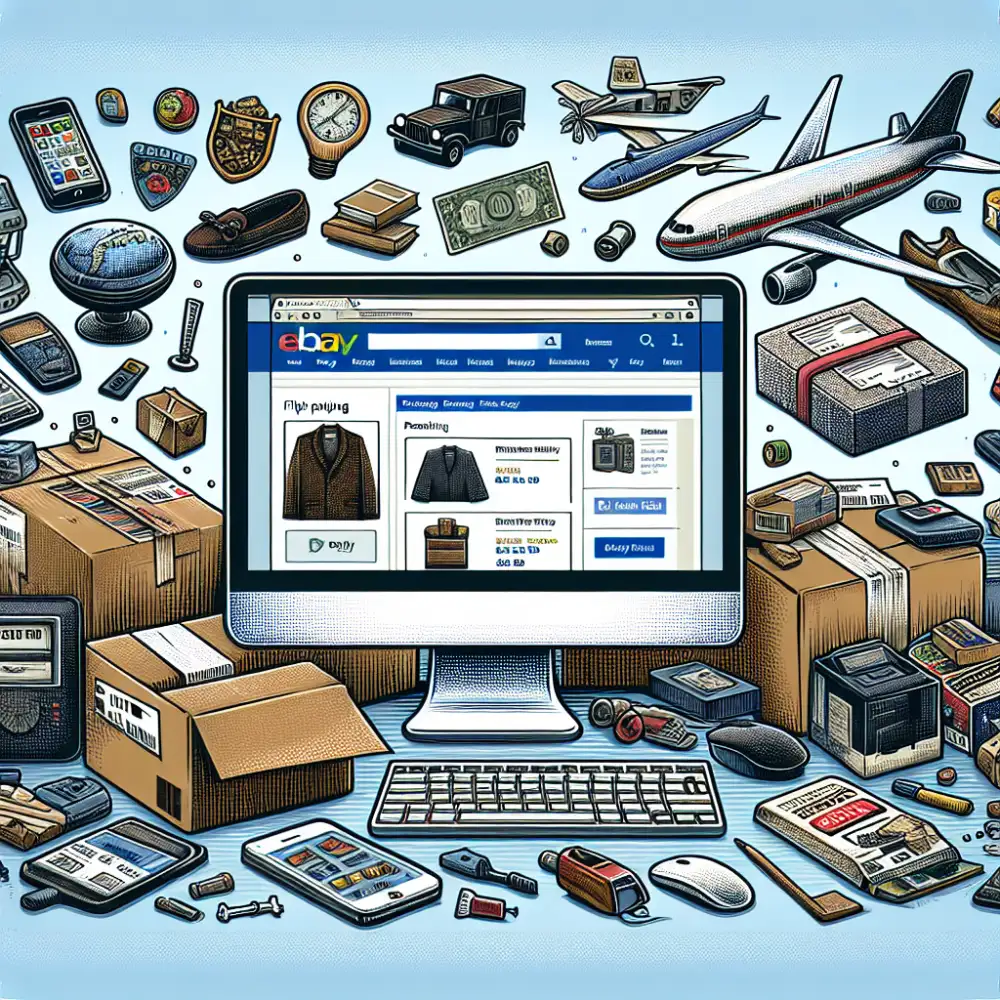Flip Items on eBay for Profit: Your Side Hustle Awaits

Sourcing Inventory
Sourcing inventory is the lifeblood of your eBay flipping business. It's where the treasure hunt begins! There are tons of places to find hidden gems that can be flipped for a profit. Thrift stores are a classic for a reason – you can often snag clothing, electronics, and home goods at bargain prices. Don't underestimate garage sales and estate sales either. These can be goldmines for unique items, especially if you're into vintage or antique goods.
Think outside the box too! Clearance sections at retail stores, online marketplaces like Facebook Marketplace or Craigslist, and even your own home can be sources of inventory. The key is to develop an eye for items that are in demand and priced low enough for you to make a profit after eBay fees and shipping costs. Remember, research is your best friend. Before you buy anything, check its sold listings on eBay to see what it's actually selling for and if there's a market for it.
Product Research
Product research is the backbone of successful eBay flipping. It's not just about finding something cheap – it's about identifying items with high profit potential and low competition. Start by exploring different categories on eBay. Look for niches you're familiar with or passionate about. This passion translates into better understanding of product value and trends. Once you have a category in mind, use eBay's search filters to narrow down your options. Sort by "newly listed" or "ending soon" to find fresh opportunities. Pay attention to "sold listings" – they are goldmines of information. Analyze the selling price, listing format, and even the item's condition. This data helps you understand what buyers are willing to pay and how to position your own listings. Don't limit yourself to individual items. Explore bundled listings or lots. Often, you can buy a collection of items at a discount and sell them individually for a profit. Tools and resources can streamline your product research. Several websites and browser extensions offer insights into trending products, estimated profits, and competitor analysis. Remember, thorough product research takes time and effort. But, the more you invest in finding the right products, the higher your chances of success in the competitive world of eBay flipping.
Market Analysis
Flipping on eBay is a popular side hustle or even a full-time gig for many. But like any business venture, success hinges on understanding the market. A thorough market analysis is crucial for eBay flippers. Start by identifying a niche. Are you passionate about vintage clothing, electronics, or collectibles? Focusing on a specific area helps you gain expertise and target your efforts effectively. Once you've chosen your niche, research popular brands, trending items, and seasonal products within that category. eBay's own search bar and trending sections can be valuable tools.

Don't forget to analyze your competition. See what similar sellers are listing, their pricing strategies, and their feedback ratings. This gives you a benchmark for your own listings. Understanding market demand is key. Are you selling high-demand items with quick turnover or niche products with less competition but potentially slower sales? Factor in seasonality. Some items, like swimwear or winter coats, have peak selling seasons.
Finally, stay updated on market trends. Follow industry blogs, join online communities, and keep an eye on eBay's trending products. The eBay market is dynamic, so continuous learning and adaptation are crucial for long-term success.
Pricing Strategy
When it comes to flipping items on eBay, pricing is everything. Price your items too high, and they'll sit unsold. Price them too low, and you'll leave money on the table. The sweet spot is finding that competitive edge that attracts buyers while maximizing your profits. Start by researching sold listings on eBay. This will give you an idea of what buyers are actually willing to pay for similar items. Don't rely solely on active listings, as those are just asking prices. Look at the "sold" listings to see the real market value.
Factor in eBay and PayPal fees, shipping costs, and your own time investment when setting your prices. A simple formula can help: Selling price = Desired profit + Item cost + eBay fees + PayPal fees + Shipping costs + Your time. Consider different pricing strategies like fixed-price listings, auctions, or "Buy It Now" with the "Best Offer" option. Each has its pros and cons depending on the item and your selling strategy. Don't be afraid to adjust your prices over time. If an item isn't selling, try lowering the price slightly. If you're getting a lot of interest, you might be able to raise it a bit.
The thrill of the hunt, the joy of the bargain, the satisfaction of the sale - eBay flipping is more than just profit, it's a lifestyle.
Elara Nightfield
Listing Optimization
Listing optimization is crucial for eBay flippers to attract buyers and maximize profits. Start with high-quality images that showcase the item clearly from multiple angles. Use natural lighting and a clean background. Write a compelling title that includes relevant keywords, brand names, and model numbers. In the item description, be detailed and accurate. Highlight key features, condition, and any flaws. Use bullet points for readability. Research popular keywords buyers use to find similar items and incorporate them naturally into your listing. Set a competitive price by analyzing recently sold listings for the same item. Offer flexible shipping options and consider free shipping to attract more buyers. Respond promptly to buyer inquiries and provide excellent customer service. Positive feedback and high ratings boost your credibility and visibility on eBay. Regularly review and update your listings to ensure they remain competitive and appealing to potential buyers.

Quality Photography
Quality photography can make or break your eBay listings. Since potential buyers can't physically examine the item, your photos are their only way to assess its condition and quality. Clear, well-lit images build trust and encourage bids. Here's how to elevate your eBay product photography:
Use natural light whenever possible. It brings out the true colors and details of your items. Avoid direct sunlight, as it can create harsh shadows. A white background is essential for professional-looking photos. It eliminates distractions and makes your items pop. Showcase the item from all angles. Include close-ups of any flaws or unique features. Potential buyers appreciate transparency.
Consider simple props to enhance the presentation, but don't distract from the main item. A clean, uncluttered background is key. Edit your photos to improve brightness, contrast, and sharpness. However, don't alter the item's appearance deceptively. Accurate representation is crucial for building trust with buyers and avoiding returns.
High-quality photos can significantly impact your sales and profits on eBay. By investing a little time and effort in your product photography, you can attract more buyers, command higher prices, and build a successful reselling business.
Compelling Descriptions
Flipping items on eBay for profit hinges on attracting buyers with compelling descriptions. Think of your descriptions as mini-advertisements. High-quality photos are a must, showcasing the item from all angles. Use clear, concise language, highlighting the item's key features and condition. Be honest about any flaws, but don't dwell on them. Instead, focus on the positives.
Is it a vintage find with a unique history? A designer handbag in pristine condition? Weave a story around your item, making it relatable and desirable. Use keywords that buyers might search for. If you're selling a vintage record player, include terms like "vinyl," "turntable," and the brand name.
Don't be afraid to inject some personality into your descriptions. A little humor can go a long way. Most importantly, be accurate and detailed. The goal is to provide enough information to instill confidence in potential buyers, encouraging them to click that "Buy It Now" button.
Shipping Logistics
Many eBay sellers start small, flipping a few items a week alongside their day job. But what if you want to turn your side hustle into a full-time income? That’s where scaling your eBay flipping business comes in.


First, analyze your current sales data. Identify your most profitable items and niches. Are you consistently selling vintage clothing or rare electronics? Focus your sourcing efforts on these high-performing areas.
Next, optimize your sourcing. Instead of randomly browsing thrift stores, build relationships with suppliers, attend estate sales, or explore online platforms for bulk deals. The key is to access inventory at lower prices, increasing your profit margins as you sell more.
Efficiency is key to handling increased volume. Streamline your listing process with clear, high-quality photos and detailed descriptions. Consider investing in tools that help you manage inventory, print shipping labels, and track sales.
As your business grows, explore different fulfillment options. Fulfilling orders yourself offers more control but can become time-consuming. Outsourcing to a third-party logistics provider (3PL) can free up your time but requires careful research and cost analysis.
Finally, remember that scaling isn’t just about selling more; it’s about building a sustainable business. Invest in your customer service, respond to inquiries promptly, and strive for positive feedback. A strong reputation will attract repeat buyers and foster long-term growth.
Managing Finances
Flipping on eBay requires more than just finding a good deal. You need to be smart about your money to maximize profits and minimize risks. Start by setting a budget for yourself. How much can you comfortably invest in inventory without stressing your finances? Stick to this budget religiously, especially when starting. It's easy to get caught up in bidding wars and overspend. Keep track of all your expenses. This includes the item's purchase price, eBay and PayPal fees, shipping costs, and any supplies used for packaging. A spreadsheet or accounting software can be incredibly helpful for this. Price your items competitively. Research similar listings to see what prices have worked for other sellers. Factor in your expenses and desired profit margin. Don't be afraid to adjust prices based on demand and competition. Offer various shipping options. Buyers appreciate choices, and it can save you money in the long run. Consider offering both economy and expedited shipping to cater to different needs. Reinvest your profits wisely. It's tempting to spend your earnings right away, but reinvesting a portion back into your business can help it grow faster. Use it to buy more inventory, upgrade your equipment, or explore new selling platforms. Don't be discouraged by occasional setbacks. Not every flip will be a home run. You might encounter unexpected expenses, fickle buyers, or items that just don't sell as well as you'd hoped. Learn from these experiences, adapt your strategies, and keep moving forward. Remember, managing your finances effectively is crucial for long-term success in eBay flipping. By staying organized, tracking your expenses, and making smart decisions, you can increase your profits and build a sustainable business.

Legal Considerations
When flipping items on eBay for profit, it's crucial to be aware of and comply with all relevant legal and tax regulations. Familiarize yourself with eBay's user agreement and policies, particularly those concerning prohibited items, accurate item descriptions, and shipping practices. Respect intellectual property rights and avoid selling counterfeit or unauthorized goods. Ensure you accurately declare income generated from your eBay sales to the appropriate tax authorities. Depending on your location and sales volume, you may need to obtain business licenses or permits. Additionally, research and comply with consumer protection laws related to refunds, returns, and product liability. It's advisable to consult with a legal professional or tax advisor to ensure you fully understand your obligations and operate your reselling business legally and responsibly. Remember, ignorance of the law is not a defense against potential legal issues.
Published: 24. 06. 2024
Category: Business



